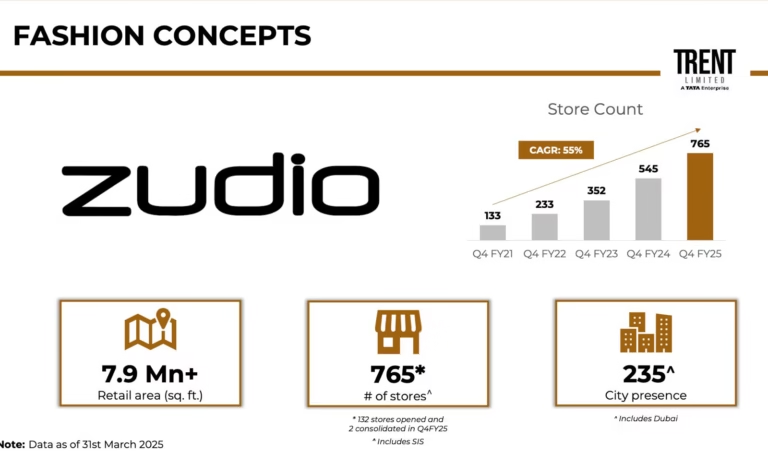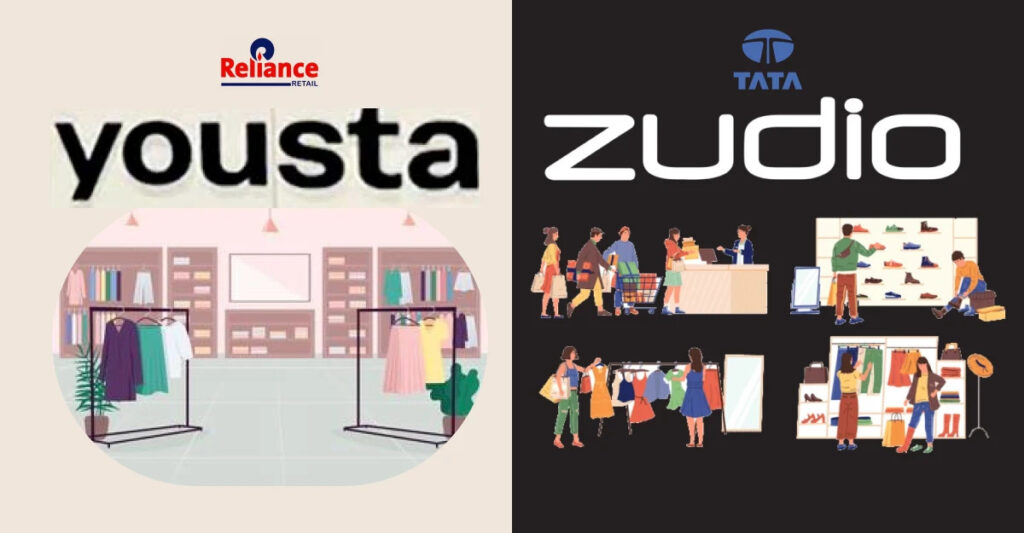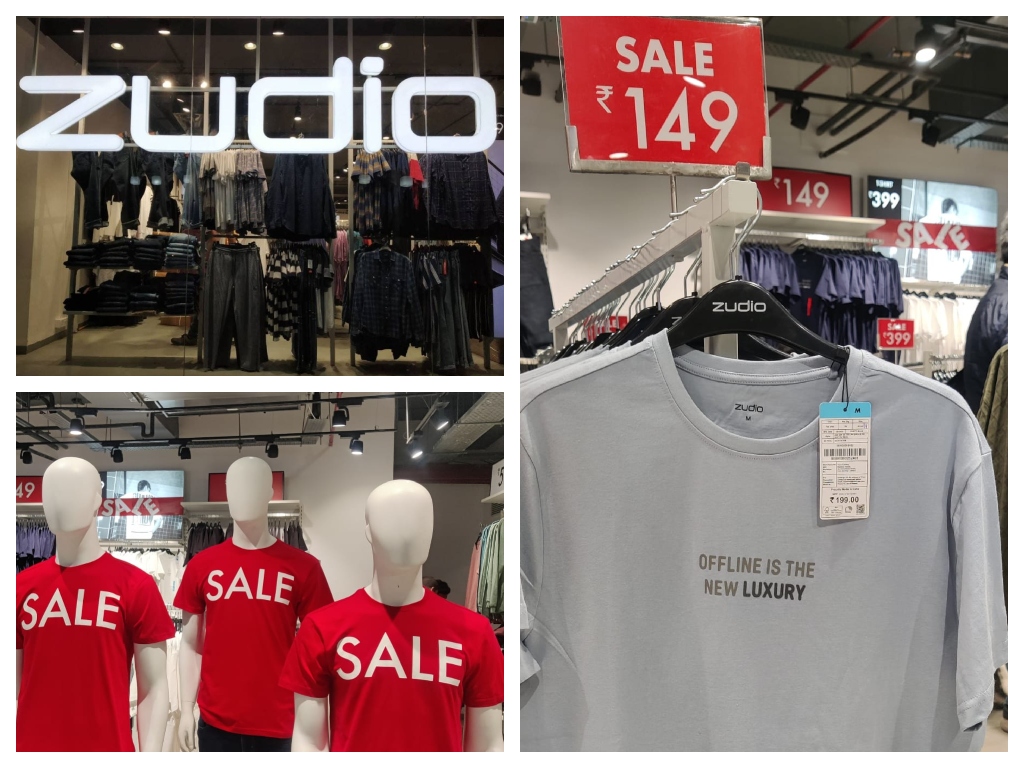Zudio, the dynamic value fashion retailer, has revolutionized the offline retail landscape, offering stiff competition to other apparel retailers. Rare is the sight of someone entering this store and not emerging with a distinctive shopping bag.
This trend underscores the brand’s irresistible appeal. Now, let’s delve into the core of the brand, examining its extensive reach and analyzing the strategic marketing approaches that form the foundation of its success.
Table of Contents
1. Background About Zudio
Zudio, a fast fashion retail clothing brand, falls under the umbrella of Trent Limited, a subsidiary of the Tata group, and was established in 2016. Since its inception, the brand has experienced remarkable growth, expanding its footprint to 411 stores across 130 cities in India (Source: Investor presentation, Sep 2023).
As of March 2025, it operates over 765 stores in 235 cities, as per Trent’s investor deck. The strategic vision behind Zudio’s launch was to leverage its swift and responsive supply chain to emulate the success of the Western brand ZARA, aiming for widespread recognition and popularity.
Operating on a franchise-owned company-operated model, Zudio has exhibited a gradual and consistent expansion, particularly in tier one and tier two cities, increasing its store count from 57 in FY 20 to an impressive 765 in FY 25.
The revenue generated by Zudio currently stands at INR 3500 crores. This robust growth trajectory underscores the brand’s success in establishing a formidable presence within the competitive landscape of the fast fashion retail sector.

2. Advantage of shared resources
Trent, Tata group’s retail arm, started in 1998, has been operating Westside, a retail fashion chain offering branded fashion apparel, footwear and accessories for men, women and children, along with home furnishings and decor.
It has over 200 retail stores across the country. Tata Group has also been Inditex SA’s partner running Zara stores in India for over a decade.
While Westside targets middle class and upper class consumers who are looking for fashionable clothing and accessories, Zudio was launched with value based pricing for trendy yet affordable clothing appealing to a wide customer base. It benefits from shared resources, infrastructure and supply chain capabilities.
When everyone today is glued to online shopping through apps etc, How has Zudio managed to disrupt offline retail to gain so much popularity through its store only model?
3. Zudio's Strategies
Zudio’s success doesn’t come from a big ad budget or digital-first approach—it comes from nailing the basics of fashion retail. Their strategy is rooted in understanding the aspirations of Indian consumers who want to stay trendy without spending too much. Here’s how Zudio has built its winning formula:
Affordable Fashion for All: Zudio targets the price-sensitive, style-hungry segment of consumers. With T-shirts starting at just ₹200, the brand makes trendy fashion accessible to a massive audience.
Private Label Control: As a private label brand, Zudio controls everything from design to distribution. This enables faster decision-making, better margins, and consistently high-quality offerings at low prices.
Agile Inventory Management: One of Zudio’s biggest strengths is its fast inventory turnover. Stores receive new styles frequently, giving customers a fresh experience each visit. They avoid seasonal overstock, focusing on evergreen and in-demand designs.
In-Store Visual Merchandising: Zudio’s stores follow a unique layout—products are not grouped by style or gender, but by price bands. This helps shoppers navigate quickly based on their budget. The spacious, black-and-white themed stores feel modern and uncluttered, encouraging exploration.
No Paper Bills, Seamless Checkout: Zudio keeps its checkout process lean and eco-conscious by eliminating paper bills. This also aligns with the brand’s youthful, minimal aesthetic.
Location Strategy: Most stores are placed in high-footfall areas of tier 2 and tier 3 cities, where demand for branded yet affordable fashion is booming.
This combination of fast fashion principles with Indian market sensibilities has helped Zudio carve a distinct identity—one that balances affordability, design, and convenience with impressive precision.
4. Zudio's Social Media Play
With very low marketing spends, Zudio leverages word of mouth advertising as a powerful channel. It also utilizes social media to connect with customers and promote its products. It capitalizes on strategic collaborations with relevant niche influencers.
It emphasizes user-generated content like photos and videos, which bring products to life with authenticity and create a strong sense of community.
Zudio Instagram posts have a high engagement rate, reflecting the strong connection with its young audience.

5. Expansion into Beauty and Jewellery
Zudio, originally known for its success in affordable apparel, is now making bold moves into the Beauty and Personal Care (BPC) and Jewellery categories to further capture the value-conscious Indian consumer.
Zudio Beauty is their dedicated beauty retail format, targeting the mass-market audience with affordable cosmetics and personal care products. Competing with brands like Elle18, Colorbar, and Sugar Cosmetics, Zudio Beauty focuses on offering budget-friendly yet trendy beauty items.
The brand launched its first store in Bengaluru, with plans to expand into Pune, Hyderabad, and Gurugram. The goal is to meet the increasing demand for affordable beauty while offering the same design-first, budget-friendly experience that made its apparel popular. According to StyleSpeak, if Zudio Beauty mirrors the success of its fashion counterpart, it could be the next breakout category for Trent.
On the jewellery front, Trent is introducing Pome, a lab-grown diamond jewellery brand. Pome is aimed at delivering affordable luxury to aspirational consumers who seek elegant yet budget-friendly jewellery options. This strategic move reflects Trent’s ambition to diversify its product mix beyond fashion and capture consumer interest across lifestyle categories.
The entry into these new segments strengthens Zudio’s position as a comprehensive value retail brand—one that offers more than fashion while staying true to its pricing promise.

6. What Zudio Does Differently (Omnichannel vs. Offline Model)
Unlike most modern retail brands, Zudio doesn’t follow the typical omnichannel playbook:
They don’t sell online. There’s no app, no e-commerce site, and no option to shop digitally.
They are not on marketplaces like Amazon, Flipkart, or Myntra.
They do very limited performance marketing—no flashy ads, paid influencer tie-ups, or discount-heavy digital campaigns.
And yet, Zudio thrives.
The reason? A great product at a great price that creates strong word-of-mouth, repeat footfalls, and high in-store conversion. Their offline-only strategy builds local buzz and exclusivity—people talk, people visit, and people buy. It turns every store opening into an event in itself.
By focusing deeply on product design, freshness, pricing, and in-store experience, Zudio has cultivated genuine brand love—without needing to chase online impressions. This deliberate approach allows them to stay lean, control margins, and scale steadily—proving that in some cases, offline-only can be a winning strategy in a digital-first world.
7. Competition
The value apparel segment is projected to witness a compound annual growth rate (CAGR) of 6% from 2020 to 2025, but the organized sub-sector is expected to surpass this, achieving a 13% CAGR.
The value fashion segment, at ₹2.5 trillion as of CY20 (57% of the total apparel market), is one of the largest and fastest-growing segments within the apparel market (Source: Livemint article, dated 20 Nov 2023).
Huge opportunity lies beyond the metros and tier 1 cities, driven by better demographics, higher incomes, and rising aspirations.
Following the success of Trent’s Zudio, national retailers have been compelled to come up with their own value fashion segments such as:
- Yousta (Reliance Retail)
- Style-Up (Aditya Birla Fashion and Retail)
- InTune (Shoppers Stop)

8. Conclusion
Zudio stores are always full—they’ve caught the pulse of the young generation’s aspiration of staying fashionable at an affordable price. The retailer identifies markets where there is an aspirational consuming class, aware of fashion and lifestyle trends. Small towns like Vapi, Davanagere, Solapur, and Jharsuguda have been put on the retail map.
Note: These are observations and thoughts by the author and have no engagement with the brand. This is an independent assessment conducted from a research perspective, and it is not intended to be interpreted as consulting services.
If you are looking to drive higher impact from your marketing , feel free to contact us at alibha@daiom.in. And we would love to do an audit and help.
Check out further our Case study on Decathlon’s Omni Channel With Endless Aisle Powered By QR
Subscribe to our Newsletter to get the access to the blog!



Excellent assessment
Glad you liked it. Keep following.